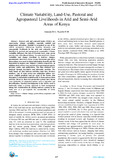Climate Variability, Land-Use, Pastoral and Agropastoral Livelihoods in Arid and Semi-Arid Areas of Kenya
Abstract
Kenya's arid and semi-arid lands (ASALs) are experiencing climate variability, especially rainfall and temperature alterations. Rainfall is recognised as one of the critical parameters influencing land-use dynamics and consequently livelihoods in the arid and semi-arid areas inhabited by pastoral and agropastoral communities. Climate variability influences the type of livestock kept, crops grown and diversity of livelihood options. To understand how climate variability and change contribute to land-use changes, questionnaire interviews, Focus Group Discussions and direct observations were used to obtain information from 98 and 100 households in Kajiado and Makueni Counties respectively. In addition, desk reviews were carried out on government reports, previous studies and publications. The data obtained were analysed through descriptive and inferential statistics. The study found out that land-use activities, land sizes, livestock numbers, type of crops grown and adaptation options vary across rainfall gradients and are some of the factors that determine if a household would diversify its farm and non-farm activities. However, there two production systems have shown some similarities in adaptation options such as migration and diversification. Therefore developments in the ASALs need to holistically adopt a systems approach to land management taking into consideration all existing land-use systems in the study area as a pre-requisite for sustainability of ASAL ecosystems.
Collections
- Journal Articles (BE) [401]

